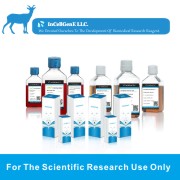

| Organism | Homo sapiens, human |
|---|---|
| Tissue | colon; derived from metastatic site: lymph node |
| Product Format | frozen |
| Morphology | epithelial |
| Culture Properties | adherent |
| Biosafety Level |
1
Biosafety classification is based on U.S. Public Health Service Guidelines, it is the responsibility of the customer to ensure that their facilities comply with biosafety regulations for their own country. |
| Disease | Dukes'''' type C, colorectal adenocarcinoma |
| Age | 51 years |
| Gender | male |
| Ethnicity | Caucasian |
| Applications |
This cell line is a suitable transfection host.
|
| Storage Conditions | liquid nitrogen vapor phase |
| Karyotype |
modal number = 50; range = 45 to 53 The stemline chromosome number is hyperdiploid with the 2S component occurring at 12% and 11 marker chromosomes were common to S metaphases. One of the 11 markers [7 (7p; 11p)] was disomic., M1 was probably an HSR but the origin of the chromosome could not be identified. |
|---|---|
| Derivation |
SW620 was initiated by A. Leibovitz, et al., from a lymph node in the same manner as was the primary adenocarcinoma from which SW480 was derived the previous year.It was isolated from the tissue of a 51-year-old Caucasian male (blood group A, Rh+) as was SW480 (ATCC CCL-228).
The line was derived from a metastasis of the same tumor from which the SW480 (ATCC CCL-228) was derived.
|
| Clinical Data |
51 years
Caucasian
male
|
| Antigen Expression | Blood type A; Rh+ |
| Oncogene | myc +; myb + ; ras +; fos +; sis +; p53 +; abl -; ros -; src - |
| Genes Expressed |
Carcinoembryonic antigen (CEA) 0.15 ng/106 cells/10 days; transforming growth factor alpha; matrilysin. The cells are negative for expression of CSAp (CSAp-) and colon antigen 3, negative. The cells are positive for keratin by immunoperoxidase staining. The line is positive for expression of c-myc, K-ras, H-ras, N-ras, Myb, sis and fos oncogenes.
|
| Tumorigenic | Yes |
| Effects |
Yes, in nude mice
(Tumors developed within 21 days at 100% frequency (5/5) in nude mice inoculated subcutaneously with 10(7) cells)
|
| Comments |
A recurrence of the malignancy resulted in a wide-spread metastasis from the colon to an abdominal mass.
The established cell line consists mainly of individual small spherical and bipolar cells lacking microvilli.
The cells synthesize only small quantities of carcinoembryonic antigen (CEA), and are highly tumorigenic in nude mice.
The cells are negative for expression of CSAp (CSAp-) and colon antigen 3, negative.
The cells are positive for keratin by immunoperoxidase staining.
The line was derived from a metastasis of the same tumor from which the SW480 (ATCC CCL-228) was derived.
There is a G -> A mutation in codon 273 of the p53 gene resulting in an Arg -> His substitution.
The line is positive for expression of c-myc, K-ras, H-ras, N-ras, Myb, sis and fos oncogenes. N-myc oncogene expression was not detected. |
| Complete Growth Medium |
The base medium for this cell line is ATCC-formulated Leibovitz''''s L-15 Medium, Catalog No. 30-2008. To make the complete growth medium, add the following components to the base medium: fetal bovine serum to a final concentration of 10%.
(Note: The L-15 medium formulation was devised for use in a free gas exchange with atmospheric air. A CO2 and air mixture is detrimental to cells when using this medium for cultivation) |
|---|---|
| Subculturing |
Volumes used in this protocol are for 75 cm2 flasks; proportionally reduce or increase amount of dissociation medium for culture vessels of other sizes. Corning® T-75 flasks (catalog #430641) are recommended for subculturing this product.
Subcultivation Ratio: A subcultivation ratio of 1:2 to 1:10 is recommended Note: For more information on enzymatic dissociation and subculturing of cell lines consult Chapter 10 in Culture of Animal Cells, a manual of Basic Technique by R. Ian Freshney, 3rd edition, published by Alan R. Liss, N.Y., 1994. |
| Cryopreservation |
Culture medium 95%; DMSO, 5%. Cell culture tested DMSO is available as ATCC Catalog No. 4-X.
|
| Culture Conditions |
Temperature: 37��C
Atmosphere: Air, 100% |


